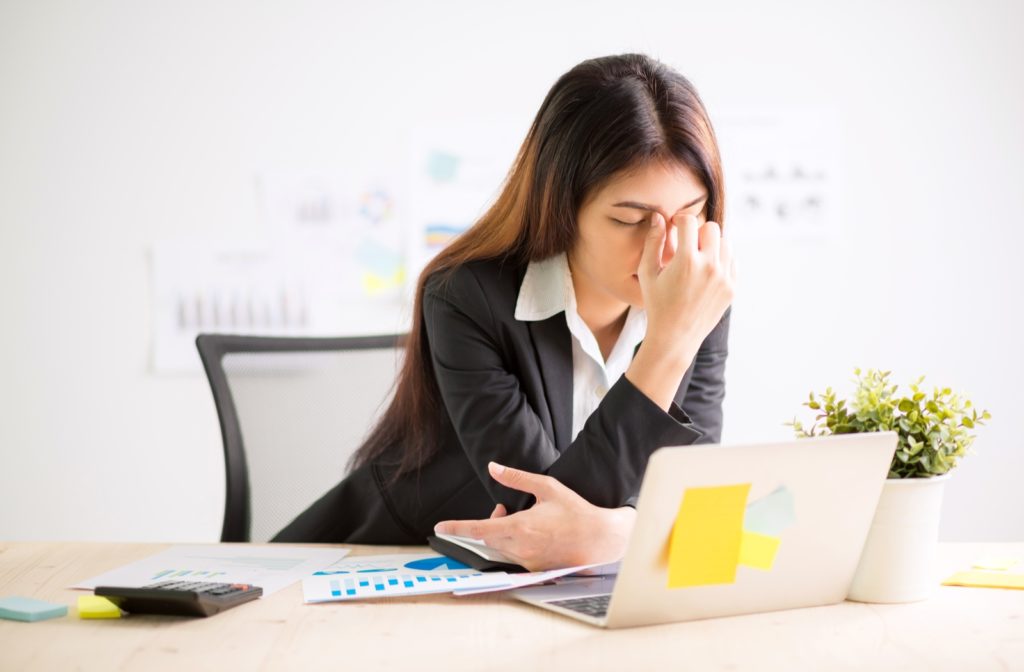Many of us have found our amount of computer use and screen time ramped up over the past few years. Even before the pandemic, there’s been an increase in how much we use our digital devices; they allow us to work, play, and connect remotely.
Though the widespread use of screens and technology is convenient and offers plenty of benefits, it may increase eye strain symptoms. Is it possible to protect your eyes from discomfort and stop vision problems? Our eye care team has put together 10 helpful ways to reduce eye strain.
What is Eye Strain?
Eye strain is caused by any activity that asks your eyes to focus for a long enough period of time that they become tired from the intense use. It may occur when reading, writing, or driving long distances.
Eye strain can also be complicated by digital device use, which can lead to digital eye strain—sometimes called computer vision syndrome.
Eye strain typically lessens when you give your eyes a break, but eye strain can lead to vision problems and trigeminal dysphoria if left unmanaged.
Symptoms of Eye Strain
Eye strain can manifest in different, uncomfortable symptoms, including:
- Sore eyes
- Tired eyes
- Burning eyes
- Blurred or double vision
- Headache
- Sore neck, shoulders, or back
- Light sensitivity
- Struggling to concentrate or keep your eyes focused
- Feeling unable to keep your eyes open
- Watery eyes
- Dry eyes
If you’re experiencing these symptoms, or any unusual or new visual ailments, visit your eye doctor to make sure your eyes are healthy. Your optometrist can also detect any underlying problems inflaming these symptoms.
10 Tips For Managing Eye Strain
Luckily, eye strain can often be remedied with some simple tweaks to your routine or workspace. If you’ve noticed feelings of eye strain creeping in, try following our tips.
1: Rest Your Eyes
It’s important to give your eyes adequate rest from any tasks that require intense focus. If you’re spending whole days using a computer, reading, and performing detail-oriented tasks—think fixing machine parts, designing any sort of pattern, or sewing— your eyes are working hard.
Make sure you take time to give your eyes a rest from close-up, focused work. Go for a walk, close your eyes and meditate, or choose an audiobook or podcast over television—your eyes will thank you.
2: Employ the 20-20-20 Rule
The 20-20-20 rule is a handy trick to give your eyes a quick break during long work periods. Every 20 minutes, take a 20-second break and focus your eyes on something 20 feet away.
The 20-20-20 rule was developed in 1991 by Dr. Jeffery Anshel, an optometrist from San Diego. He also suggests that we remember the 3Bs—“blink, breathe, break”—to maintain healthy workplace ergonomics. Dr. Anshel proposed that the 20-20-20 rule be used during the “break” portion of this adage.

3: Watch For Screen Glare
Screen glare can interfere with your vision by scattering the light inside your eye, which leads to unclear images. This means your eyes need to work even harder to keep your sight right.
Screen glare can be neutralized by making sure your computer or device is positioned where light from any windows can’t bounce off it. It’s sometimes easiest to determine where the glare is worst by turning off your screen to find where the light reflects.
Certain glasses coatings can also help protect against glare. Ask your optician about anti-reflective coatings when you get your next pair of glasses.
4: Check Your Workstation Ergonomics
Making sure you treat your body right and maintain a healthy posture while working can help curb eye strain. Workplace ergonomics include:
- Sitting with good posture—feet resting evenly on the floor, back straight, not slouching
- Keeping any screens about an arm’s length away & just below eye level
- Keeping a document holder at the same level as your screen if you switch between paper & digital
5: Use the Right Light
Lighting is key to good vision. The same lighting may not work for everyone, and using only overhead lighting may lead to eye strain. Use a task light or desk lamp to adjust the lighting to a level that suits you. Activities like reading, sewing, and anything that requires attention to detail can also benefit from direct lighting that’s bright enough.
6: Keep Your Environment Comfortable
Your eyes can be affected by the environment around you. Air conditioning, indoor heating, a fan blowing onto your eyes—these can all impact your eyes’ comfort. Office environments with low humidity and indoor air pollution may increase the risk of dry eyes or digital eye strain.
Avoid working with a fan or heater aimed towards our face. You can also keep a humidifier nearby to reduce dry eye risk.
7: Adjust Your Computer Settings
Your computer’s display can be customized to be comfortable for you. Adjust the contrast, text size, and even the colouring of the screen. Your computer may also have different settings like a blue-light reducing “night mode” or a “dark mode” that makes text light over a darker background.
8: Use Neurolens® Glasses Lenses
Sometimes eye strain may be due to slight misalignments in the eye. These can be corrected with a special type of lenses called Neurolens®, which uses strategically placed prisms to correct vision. Speak with your optometrist to find out if these lenses may help you.
9: Try Blue Light Filters
Blue light is all around us: it’s produced by the sun, artificial lights, and our digital device screens. Though it has many benefits (such as keeping us alert, improving our memory and cognitive function, and keeping skin healthy) it can also be harmful in large quantities. Blue light has been linked to macular degeneration and can interfere with your sleep patterns.
For a bit of extra protection against blue light, ask your optometrist or optician if there’s a blue light lens or coating that’s right for you.
10: Go for Regular Eye Exams
Routine eye exams are the backbone of good eye health. Your optometrist can look into any eye health issues or vision problems during these exams. Your prescription can be updated, and any eye conditions can be tackled as quickly as possible. Visit your optometrist if you’re experiencing eye strain.
Ease Eye Strain with Your Optometrist
Avoiding anything that may strain the eyes is nearly impossible. Using computer screens, smartphones, and reading are part of most people’s everyday lives. Thankfully, eye strain is a manageable condition, and with the help of your eye care team and their tips, you can regain comfortable vision.




